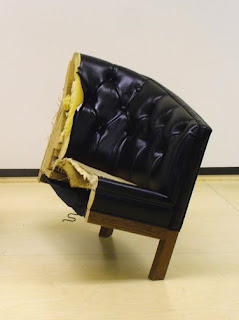
The most interesting show I've seen in a Seattle gallery in a while is at Howard House through the end of the month (plus one). You are encouraged to go see it. And don't be fooled by the gallery's unintentionally diminishing press release, or Seattle Weekly's glowing, inane review, or even the artist's not-so-interesting comments about his own inspirations; this show actually is worth seeing.
I repeat, unintentionally diminishing. The trouble with everything I've been reading about Sean M. Johnson's This Growing Up Stuff ... is that it all focuses narrowly on the what of Johnson's objects, or worse, the why behind his making them. False Identity 1 and 2, for example, may indeed have been created in order to point to the artist's racial background, but these tilted chair halves feel more like two takes on the same subject à la Robert Indiana than they do Michael Jackson. And don't even get me started on I Was Nine. Every positive sentiment I have about this show should be understood to apply to every piece except that one.
Johnson's work is bigger than the personal narratives that serve to drive his process. It's aggressive and uncomfortable, even as it occasionally manages to be delicate. That desk attached to the wall with nothing but push pins and rubber bands is rather a prickly thing, transforming the otherwise cheerful office supplies into forcefully embedded anchors, and encouraging a cautious approach considering the obvious strain on each diminutive rubber strip. In the front gallery, the threatening confrontation of Cautionary Tale comes not from its shattered porcelain inhabiting our space, but from the lashing down that arrests the motion of the cabinet. Every element strains against its suspended state. There's something of a Rachel Whiteread "familiar made strange" [1] in these objects, and even more of Richard Serra's disorienting uneasiness. Referring to Serra's work, architect Peter Eisenman's words could just as easily be applied to Johnson: "Whether or not the pieces actually fall down, they create the anxiety of the maker and the viewer being not in control." [2] At least Johnson's in good company.
For all there is to experience in the gallery, it is quite possible to miss these effects by simply noting the factual arrangements of the objects, and being amused by the novelty. Better to look more closely. If you do, you might notice just how precariously each False Identity is perched, or catch BFFs visually teetering as it sits physically perfectly still. As Nancy Stoaks, who works in the gallery, put it, this work "resonates" beyond the literal. If you take the time to take it in, it should become apparent that in this show, the artist's grasp seems to exceed his reach.
- Helen Molesworth, Part Object Part Sculpture, (University Park, Pennsylvania: The Pennsylvania State University Press, 2005), 211.
- Richard Serra/Peter Eisenman, "Interview with Peter Eisenman," (1983), in Jon Wood, David Hulks, and Alex Potts, Modern Sculpture Reader, (Leeds: Henry Moore Institute, 2007), 347.



Stephen, great review. I wish I could see it. Really well written.
ReplyDelete